Abstract
1. The ventilatory sensitivity to carbon dioxide obtained from a step-ramp CO2 challenge was compared to the CO2 sensitivity from the steady-state method. 2. Experiments were performed in nine healthy male subjects against a background of hyperoxia and in two subjects against a background of normoxia. 3. In each subject experiments were performed in which the stepwise increase in end-tidal PCO2 above its resting value (A) was varied (range 0-2 kPa) and the subsequent rate of rise of end-tidal PCO2 in time (R) kept constant at 0.6 or 0.8 kPa min-1. 4. The results of the hyperoxic experiments show that the slope of the non-steady-state ventilatory response to CO2 (Sn) is greatly influenced by the magnitude of A. An increase of A of 1 kPa results in a 54% increase of the ratio non-steady-state ventilatory CO2 sensitivity to steady-state ventilatory CO2 sensitivity (Ss). The magnitude of R plays a minor role in determining Sn. The normoxic experiments gave similar results. 5. In experiments performed during hyperoxia Sn approximates Ss when the magnitude of A is 0.5 kPa. 6. The results are discussed and related to a physiological model. Simulations with representative values for the model parameters are in fair agreement with experimental values.
Full text
PDF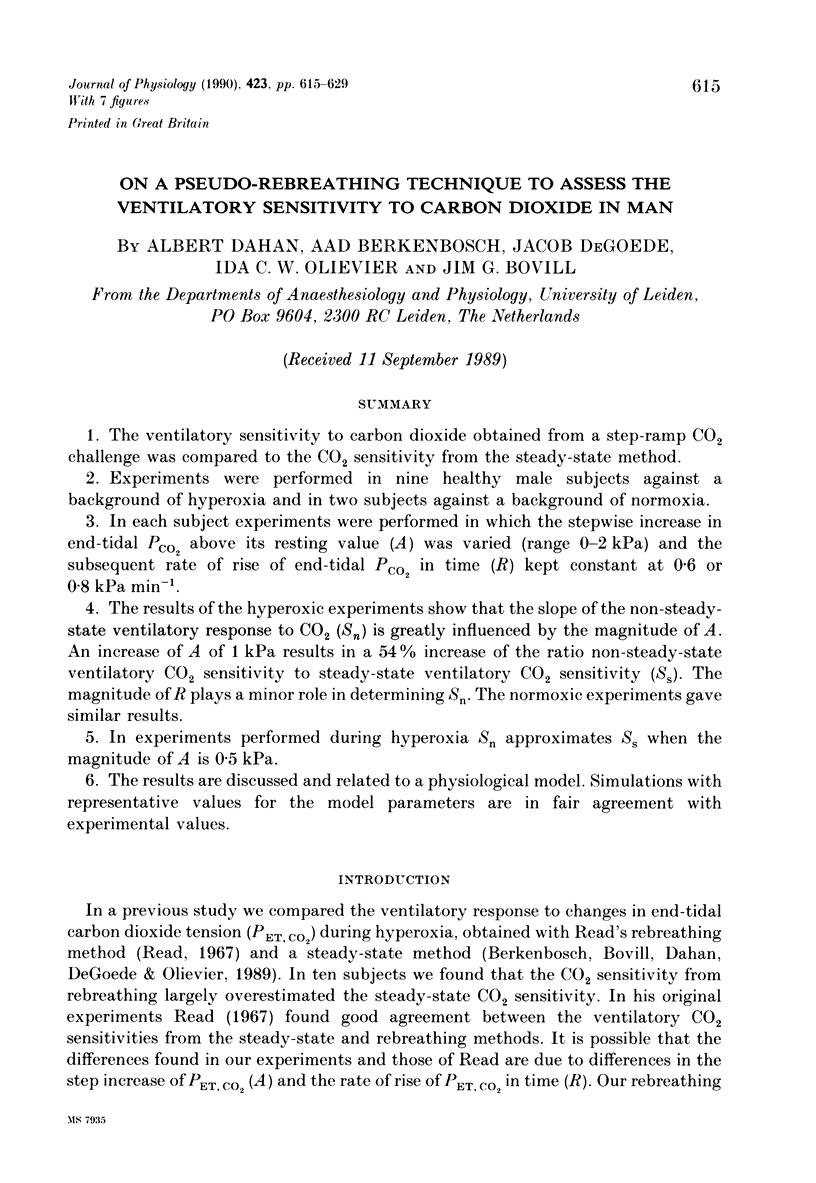

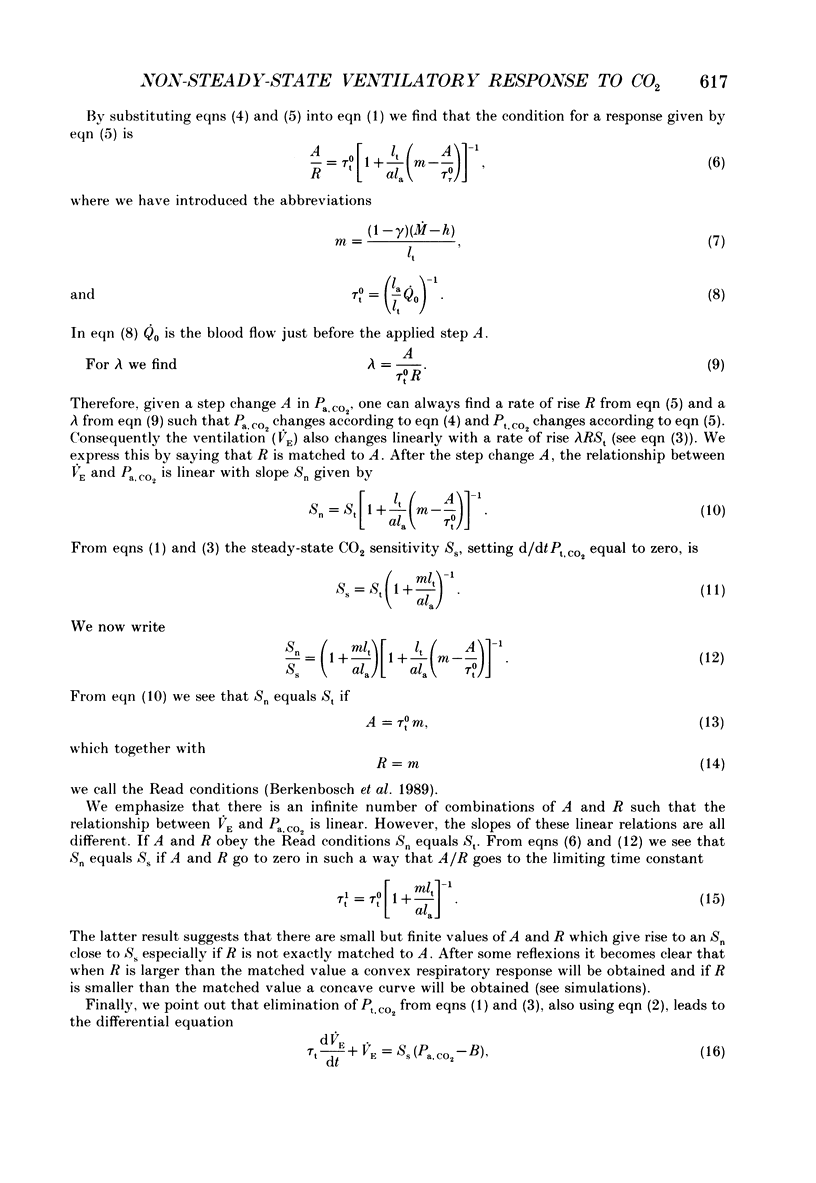








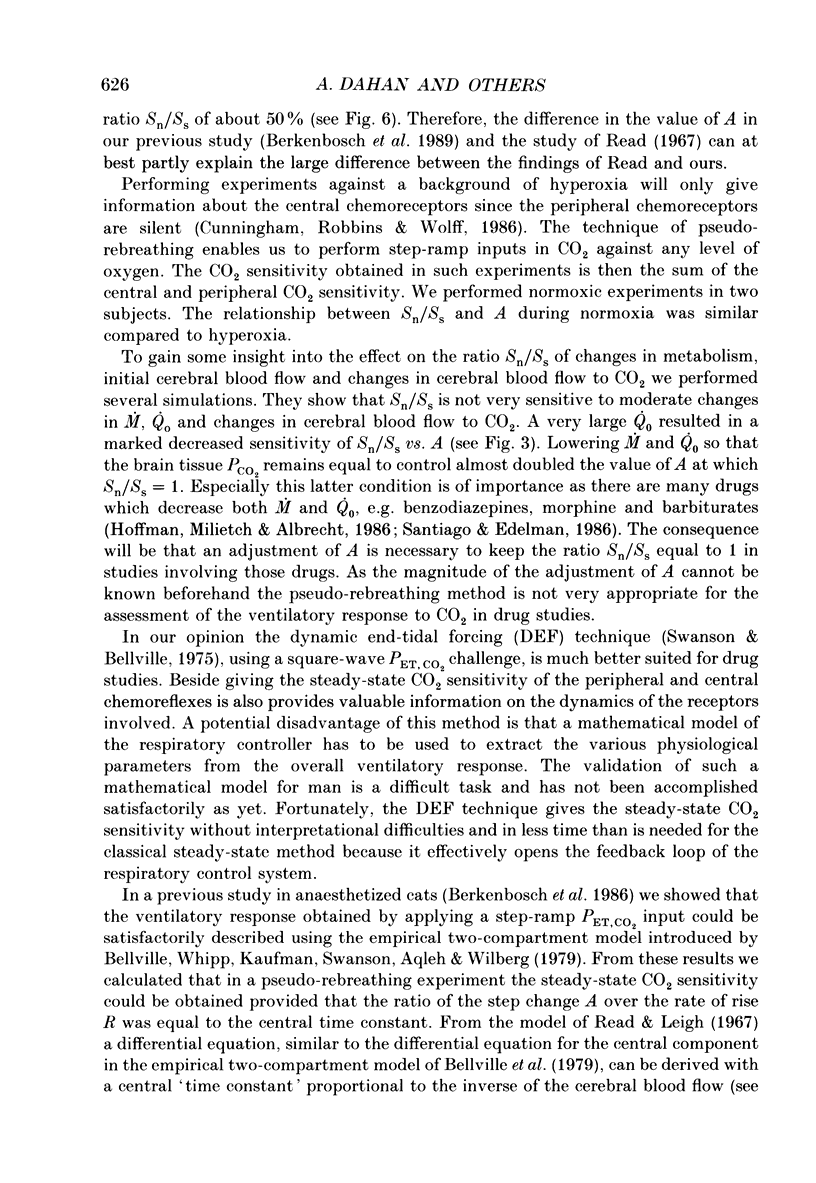
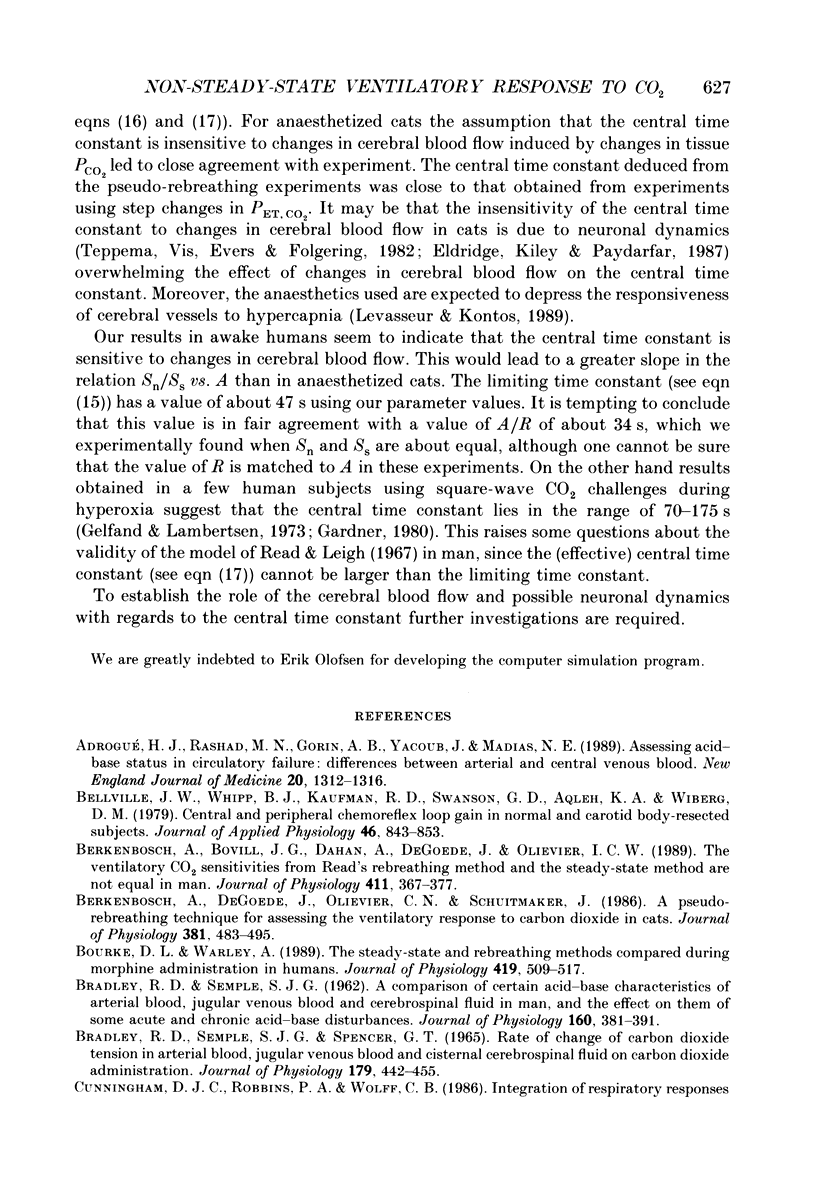

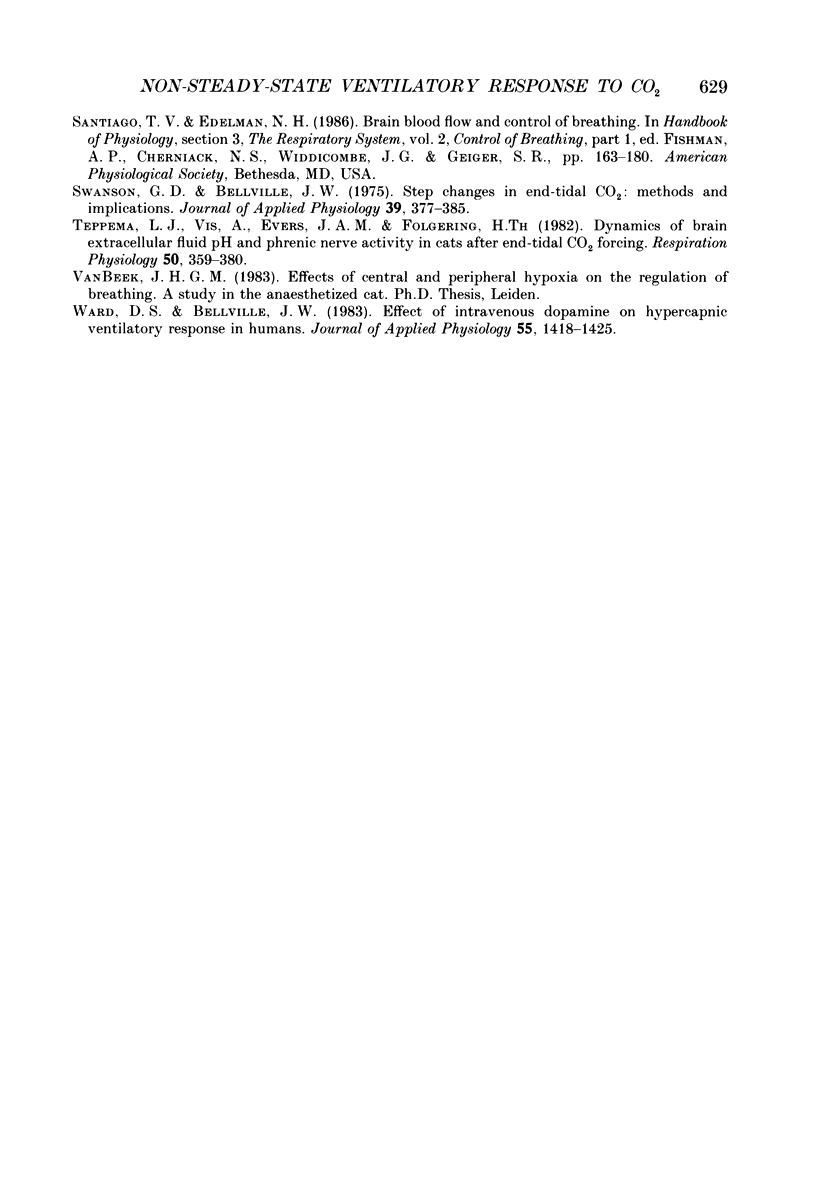
Selected References
These references are in PubMed. This may not be the complete list of references from this article.
- Adrogué H. J., Rashad M. N., Gorin A. B., Yacoub J., Madias N. E. Assessing acid-base status in circulatory failure. Differences between arterial and central venous blood. N Engl J Med. 1989 May 18;320(20):1312–1316. doi: 10.1056/NEJM198905183202004. [DOI] [PubMed] [Google Scholar]
- BRADLEY R. D., SEMPLE S. J. A comparison of certain acidbase characteristics of arterial blood, jugular venous blood and cerebrospinal fluid in man, and the effect on them of some acute and chronic acid-base disturbances. J Physiol. 1962 Mar;160:381–391. doi: 10.1113/jphysiol.1962.sp006853. [DOI] [PMC free article] [PubMed] [Google Scholar]
- Bellville J. W., Whipp B. J., Kaufman R. D., Swanson G. D., Aqleh K. A., Wiberg D. M. Central and peripheral chemoreflex loop gain in normal and carotid body-resected subjects. J Appl Physiol Respir Environ Exerc Physiol. 1979 Apr;46(4):843–853. doi: 10.1152/jappl.1979.46.4.843. [DOI] [PubMed] [Google Scholar]
- Berkenbosch A., Bovill J. G., Dahan A., DeGoede J., Olievier I. C. The ventilatory CO2 sensitivities from Read's rebreathing method and the steady-state method are not equal in man. J Physiol. 1989 Apr;411:367–377. doi: 10.1113/jphysiol.1989.sp017578. [DOI] [PMC free article] [PubMed] [Google Scholar]
- Berkenbosch A., DeGoede J., Olievier C. N., Schuitmaker J. J. A pseudo-rebreathing technique for assessing the ventilatory response to carbon dioxide in cats. J Physiol. 1986 Dec;381:483–495. doi: 10.1113/jphysiol.1986.sp016340. [DOI] [PMC free article] [PubMed] [Google Scholar]
- Bourke D. L., Warley A. The steady-state and rebreathing methods compared during morphine administration in humans. J Physiol. 1989 Dec;419:509–517. doi: 10.1113/jphysiol.1989.sp017883. [DOI] [PMC free article] [PubMed] [Google Scholar]
- Bradley R. D., Semple S. J., Spencer G. T. Rate of change of carbon dioxide tension in arterial blood, jugular venous blood and cisternal cerebrospinal fluid on carbon dioxide administration. J Physiol. 1965 Aug;179(3):442–455. doi: 10.1113/jphysiol.1965.sp007672. [DOI] [PMC free article] [PubMed] [Google Scholar]
- Drummond G. B., Goodenough P. C. Automatic correction for drift in an integrator for phasic signals. Med Biol Eng Comput. 1977 Nov;15(6):688–691. doi: 10.1007/BF02457928. [DOI] [PubMed] [Google Scholar]
- Eldridge F. L., Kiley J. P., Paydarfar D. Dynamics of medullary hydrogen ion and respiratory responses to square-wave change of arterial carbon dioxide in cats. J Physiol. 1987 Apr;385:627–642. doi: 10.1113/jphysiol.1987.sp016511. [DOI] [PMC free article] [PubMed] [Google Scholar]
- FOWLE A. S., CAMPBELL E. J. THE IMMEDIATE CARBON DIOXIDE STORAGE CAPACITY OF MAN. Clin Sci. 1964 Aug;27:41–49. [PubMed] [Google Scholar]
- Fencl V., Vale J. R., Broch J. A. Respiration and cerebral blood flow in metabolic acidosis and alkalosis in humans. J Appl Physiol. 1969 Jul;27(1):67–76. doi: 10.1152/jappl.1969.27.1.67. [DOI] [PubMed] [Google Scholar]
- Gardner W. N. The pattern of breathing following step changes of alveolar partial pressures of carbon dioxide and oxygen in man. J Physiol. 1980 Mar;300:55–73. doi: 10.1113/jphysiol.1980.sp013151. [DOI] [PMC free article] [PubMed] [Google Scholar]
- Gelfand R., Lambertsen C. J. Dynamic respiratory response to abrupt change of inspired CO2 at normal and high PO2. J Appl Physiol. 1973 Dec;35(6):903–913. doi: 10.1152/jappl.1973.35.6.903. [DOI] [PubMed] [Google Scholar]
- Hoffman W. E., Miletich D. J., Albrecht R. F. The effects of midazolam on cerebral blood flow and oxygen consumption and its interaction with nitrous oxide. Anesth Analg. 1986 Jul;65(7):729–733. [PubMed] [Google Scholar]
- Jacobi M. S., Patil C. P., Saunders K. B. Transient, steady-state and rebreathing responses to carbon dioxide in man, at rest and during light exercise. J Physiol. 1989 Apr;411:85–96. doi: 10.1113/jphysiol.1989.sp017562. [DOI] [PMC free article] [PubMed] [Google Scholar]
- Javaheri S., Evers J. A., Teppema L. J. Increase in ventilation caused by aminophylline in the absence of changes in ventral medullary extracellular fluid pH and carbon dioxide tension. Thorax. 1989 Feb;44(2):121–125. doi: 10.1136/thx.44.2.121. [DOI] [PMC free article] [PubMed] [Google Scholar]
- Javaheri S., Teppema L. J., Evers J. A. Effects of aminophylline on hypoxemia-induced ventilatory depression in the cat. J Appl Physiol (1985) 1988 May;64(5):1837–1843. doi: 10.1152/jappl.1988.64.5.1837. [DOI] [PubMed] [Google Scholar]
- Kety S. S., Schmidt C. F. THE EFFECTS OF ALTERED ARTERIAL TENSIONS OF CARBON DIOXIDE AND OXYGEN ON CEREBRAL BLOOD FLOW AND CEREBRAL OXYGEN CONSUMPTION OF NORMAL YOUNG MEN. J Clin Invest. 1948 Jul;27(4):484–492. doi: 10.1172/JCI101995. [DOI] [PMC free article] [PubMed] [Google Scholar]
- LAMBERTSEN C. J. Carbon dioxide and respiration in acid-base homeostasis. Anesthesiology. 1960 Nov-Dec;21:642–651. doi: 10.1097/00000542-196011000-00008. [DOI] [PubMed] [Google Scholar]
- LAMBERTSEN C. J., HALL P., WOLLMAN H., GOODMAN M. W. Quantitative interactions of increased Po2 and Pco2 upon respiration in man. Ann N Y Acad Sci. 1963 Jun 24;109:731–742. doi: 10.1111/j.1749-6632.1963.tb13502.x. [DOI] [PubMed] [Google Scholar]
- LANDMESSER C. M., COBB S., PECK A. S., CONVERSE J. G. Respiratory responses to carbon dioxide transients in normal volunteers. Anesthesiology. 1957 Nov-Dec;18(6):807–830. doi: 10.1097/00000542-195711000-00001. [DOI] [PubMed] [Google Scholar]
- Levasseur J. E., Kontos H. A. Effects of anesthesia on cerebral arteriolar responses to hypercapnia. Am J Physiol. 1989 Jul;257(1 Pt 2):H85–H88. doi: 10.1152/ajpheart.1989.257.1.H85. [DOI] [PubMed] [Google Scholar]
- Linton R. A., Poole-Wilson P. A., Davies R. J., Cameron I. R. A comparison of the ventilatory response to carbon dioxide by steady-state and rebreathing methods during metabolic acidosis and alkalosis. Clin Sci Mol Med. 1973 Aug;45(2):239–249. doi: 10.1042/cs0450239. [DOI] [PubMed] [Google Scholar]
- Nishimura M., Suzuki A., Nishiura Y., Yamamoto H., Miyamoto K., Kishi F., Kawakami Y. Effect of brain blood flow on hypoxic ventilatory response in humans. J Appl Physiol (1985) 1987 Sep;63(3):1100–1106. doi: 10.1152/jappl.1987.63.3.1100. [DOI] [PubMed] [Google Scholar]
- Read D. J. A clinical method for assessing the ventilatory response to carbon dioxide. Australas Ann Med. 1967 Feb;16(1):20–32. doi: 10.1111/imj.1967.16.1.20. [DOI] [PubMed] [Google Scholar]
- Read D. J., Leigh J. Blood-brain tissue Pco2 relationships and ventilation during rebreathing. J Appl Physiol. 1967 Jul;23(1):53–70. doi: 10.1152/jappl.1967.23.1.53. [DOI] [PubMed] [Google Scholar]
- Swanson G. D., Bellville J. W. Step changes in end-tidal CO2: methods and implications. J Appl Physiol. 1975 Sep;39(3):377–385. doi: 10.1152/jappl.1975.39.3.377. [DOI] [PubMed] [Google Scholar]
- Teppema L. J., Vis A., Evers J. A., Folgering H. T. Dynamics of brain extracellular fluid pH and phrenic nerve activity in cats after end-tidal CO2 forcing. Respir Physiol. 1982 Dec;50(3):359–380. doi: 10.1016/0034-5687(82)90029-9. [DOI] [PubMed] [Google Scholar]
- Ward D. S., Bellville J. W. Effect of intravenous dopamine on hypercapnic ventilatory response in humans. J Appl Physiol Respir Environ Exerc Physiol. 1983 Nov;55(5):1418–1425. doi: 10.1152/jappl.1983.55.5.1418. [DOI] [PubMed] [Google Scholar]


